Part Two: Religion
Preface: It should be noted that very little attention has been given to Vulcan religion in on-screen Star Trek dialogue. Therefore, the conclusions drawn below are merely theories based upon the facts we have seen and cannot be considered “canon.”
Religion is a very complex concept. The word, “religion,” has many diverse connotations in a single culture. When examining religion across more than one culture it is important to remember that the word, as well as the concept will have different and possibly strange meanings to the examiner. I offer this definition as a starting point:
Religion n. 1. The belief in a superhuman controlling power, esp. in a personal god or gods entitled to obedience and worship. 2. The exp ression of this in worship. 3. A particular system of faith and worship. 4. Life under monastic vows (the way of religion). 5. A thing that one is devoted to (football is their religion). (The Oxford Reference Dictionary, 1996).
For the purposes of this essay, we will be most concerned with the third definition.
According to http://www.religioustolerance.org there are 19 major Earth religions. These can then be subdivided into 270 major religious organizations and many, many smaller ones. For example, approximately 34, 000 separate Christian groups have been identified.
In comparison, we have only seen glimpses of what would appear to be a single Vulcan religion. These glimpses come to us largely through studying the life of Spock. We know that there are at least two major Vulcan philosophies; the one fathered by Surak and the one followed by Sybok and the V’tosh Ka’tur (Vulcans without logic). It is quite possible that there is more than one Vulcan religion and we simply have not seen evidence of the others yet. Logically, we can only discuss that which we have seen.
There are only two Vulcan ceremonies or rituals that we have witnessed in their entirety. The first is Spock’s koon-ut-kal-if-fee (marriage or challenge) ritual in 2267 (ST: TOS “Amok Time”). The second is Spock’s fal-tor-pan (rejoining) ritual in 2285 (ST III: The Search for Spock). We also witness some of T’Pol’s marriage to Koss in 2154 (ST: ENT “Home”). The author assumes that the marriages are religious ceremonies instead of civil ceremonies by virtue of the fact that they are so highly ritualistic. The spiritual nature of the fal-tor-pan ceremony seems certain. Also, the fact that it takes place at Mount Seleya which we know is a sacred location to Vulcans, makes its religious nature appear evident.
Besides these events we have precious little information about Vulcan religion. We know from Sybok that the Vulcan equivalent to Eden is called Sha Ka Ree (ST V: The Final Frontier). We also know that Sha Ka Ree is considered mythical. In a similar vein, we know that in at least one strain of Vulcan mythology there were gods of war, death and peace (ST: TNG “Gambit, Part II”). The fact that these are referred to as being part of Vulcan mythology leads me to believe they are not part of a “living religion.” In any event, there are no references to Sha Ka Ree or to these gods on clothing that we have seen so they bear little relevance to this discussion. I mention them only to give a more complete idea of what we know of Vulcan religion.
Most of the clothing worn during Spock’s koon-ut-kal-if-fee ritual is beautiful, though lacking in symbols and markings. The single exception is T’Pau’s clothing which features a large, elaborate necklace with two symbols. The lower one is indistinct and seemingly unremarkable. The upper one, though simple, has some features worth noting.
The combination of a triangle and a circle is important as those are the basic shapes making up the IDIC. Though this is not a configuration of the IDIC we have ever seen elsewhere it is possible it is meant to represent the same idea. Triangles themselves appear with some frequency in Vulcan religious clothing designs as we will see below. Perhaps they are references to the unique shape of Mt. Seleya or perhaps they are merely aesthetic choices.
The clothing worn leading up to and during Spock’s fal-tor-pan ritual is filled with many, many symbols. When Spock’s party arrives on Vulcan they are greeted by a large contingent of priests and priestesses from Mt. Seleya. We do not see them clearly but fortunately, we now have detailed images of their apparel. Below are more than twenty distinct symbols which are rendered on gemstones attached to the clothing of priests and priestesses.
Unfortunately, we do not know the meanings of these beautiful symbols. Given the wide variety of the shaped gemstones upon which the symbols appear, it is possible that the combination of the shape and symbol might have an additional meaning. Religious symbols are usually worn for one of two reasons: First, as a sign to others of significant religious status or position and second, as a personal reminder of ones’ faith. It is entirely possible that the above contains examples of both.
Among those officiating at the ceremony the greatest commonality in dress is the triangular shape. It is worthy of note in that it is repeated so frequently, and, as we shall see in part three of these essays, it is repeated not only in clothing designs but also in art and architecture. Below, we can see the prominent triangles in the robes of High Priestess T’Les as well as in the shapes of the large jewelry worn by the accompanying Vulcan maidens.
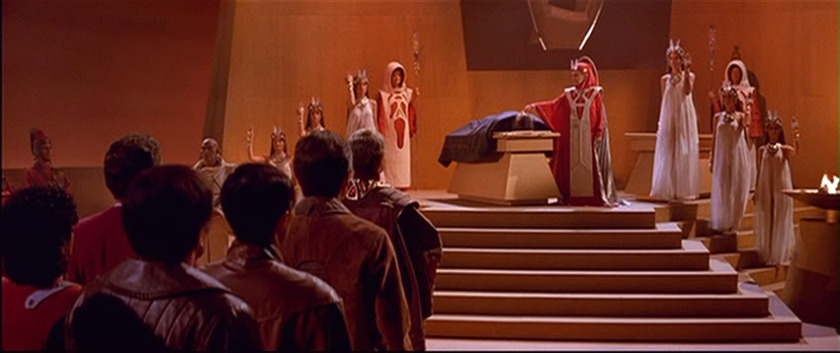
We have recently gained clearer images of the jewelry worn by the maidens.

In addition, the triangular shapes are prominent in the clothing of these Vulcan monks or masters.
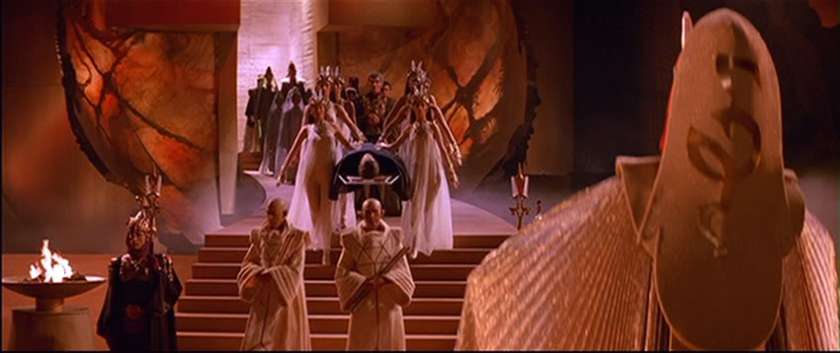
Similarly costumed masters were seen in 2271 when Spock ended his work to attain Kolinahr (ST: TMP).
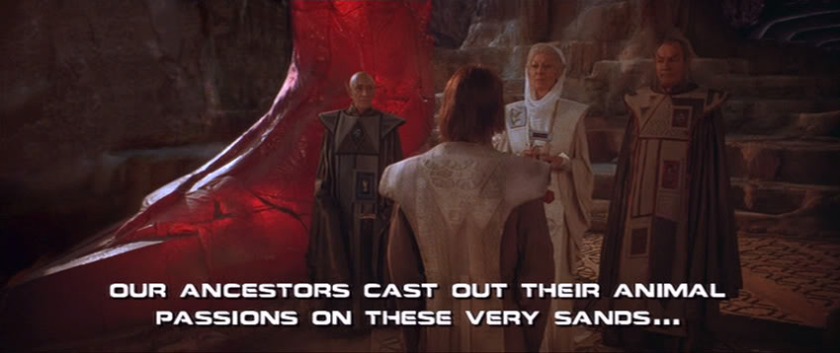
And the triangular patterns were also seen in the robes worn by Spock at the time. Notice the pattern is echoed in the carvings on the ground as well.
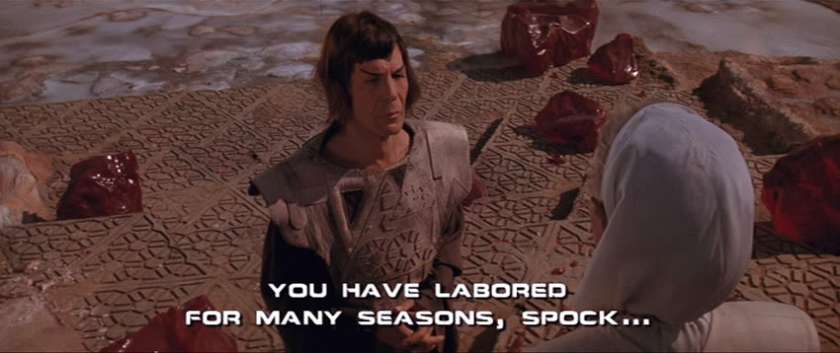
I have already speculated upon the possible meanings and importance of this shape. Unfortunately, we simply cannot know for certain.
Two other individuals of note were in attendance at the fal-tor-pan ceremony: First, a Vulcan musician responsible for ritualistically performing on a gong.
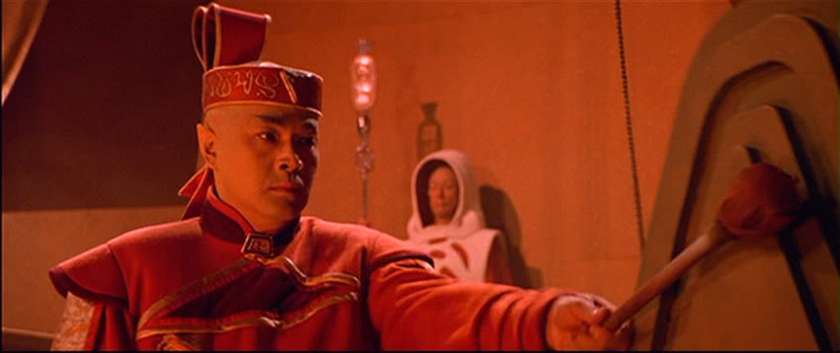
A similar gong was used during Spock’s koon-ut-kal-if-fee ceremony. This person’s headdress features a gemstone with accompanying symbol and a long script around his head. These symbols are clearly of the same style as the ones above but seem to be distinct. This means there are at least 24 symbols of this variety. You may notice his clothing also incorporates prominent triangles.
The second person of note is the priestess standing to the extreme left here.
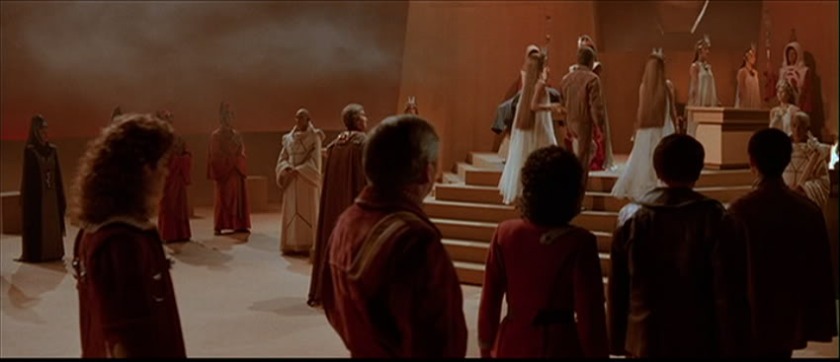
She is dressed in a long, dark tabard of a kind we have not seen elsewhere. The symbol on the front of the tabard is related to other Vulcan writing and symbols we have seen but it is somewhat more angular than most of the others. It also appears to be two symbols attached to one another. The symbol on the back of the tabard is even more unique in that it is presented horizontally. In Vulcan clothing, we have seen this only once previously: on the robes of the Vulcan master performing T’Pol’s wedding ceremony in 2154. Here are two clearer images of the symbols on the tabard.
We can only speculate at the meaning of this. Given that it appears on the rear of the tabard it might be a less significant symbol than the vertical one on the front.
The horizontal symbol on the master’s robe in 2154 is of the same type of Vulcan calligraphy in which the trinity of rata, tafar and tapan were rendered on the clothing of the commander of the T’plana-Hath in 2063. Again, we can only speculate as to the meaning of its horizontal presentation. Possibly it is a matter of personal taste on the part of the master. Certainly it is unique.
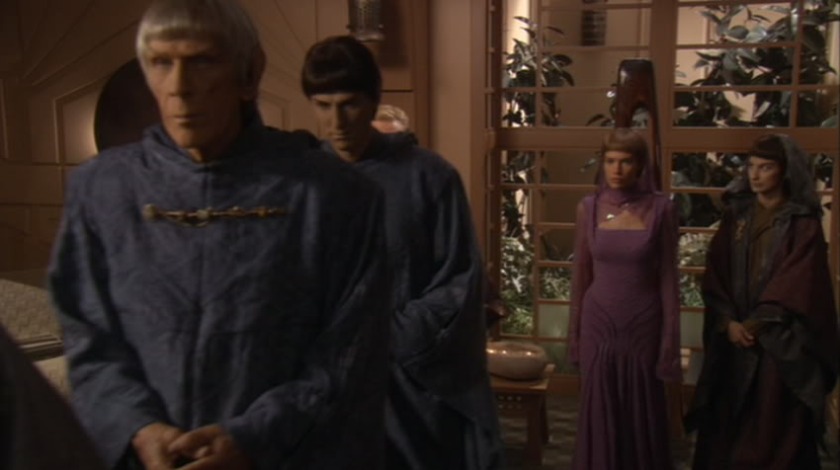
The Vulcan master who instructed a young Tuvok wore gemstones with symbols on them (ST: VOY “Gravity”).

On occasion, we have seen shaped gemstones with symbols on them on the clothing of politicians and diplomats. Beginning in 2286, some of the Vulcan diplomats in the UFP Security Council wore these (ST IV: The Voyage Home). Also, note the prominent triangles in their clothing design.
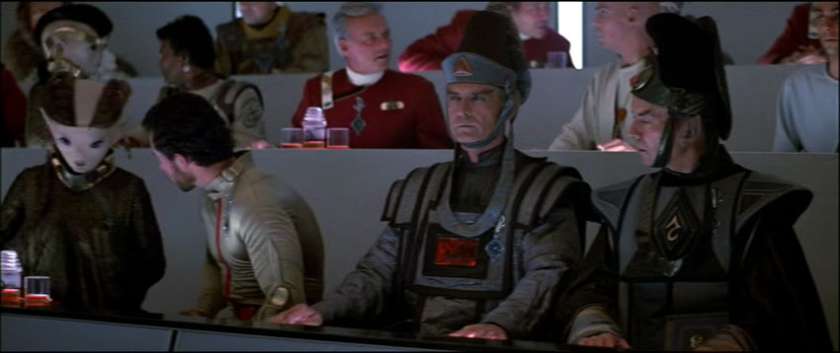
Ambassador Sarek wore a jeweled necklace in the UFP Council which had a symbol on it as well. Worth note on Sarek’s robes is the reversed rata symbol.
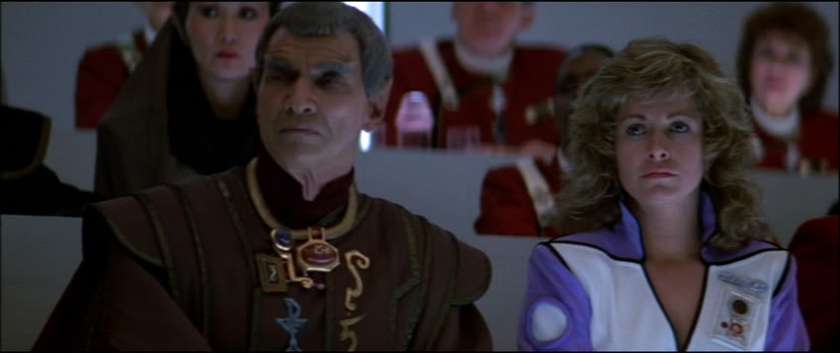
Also, in 2293 some of the Vulcan attendees at the Khitomer Peace Conference wore these. You may also notice a headdress similar to that worn by the gong player at the fal-tor-pan ceremony (ST VI: The Undiscovered Country).
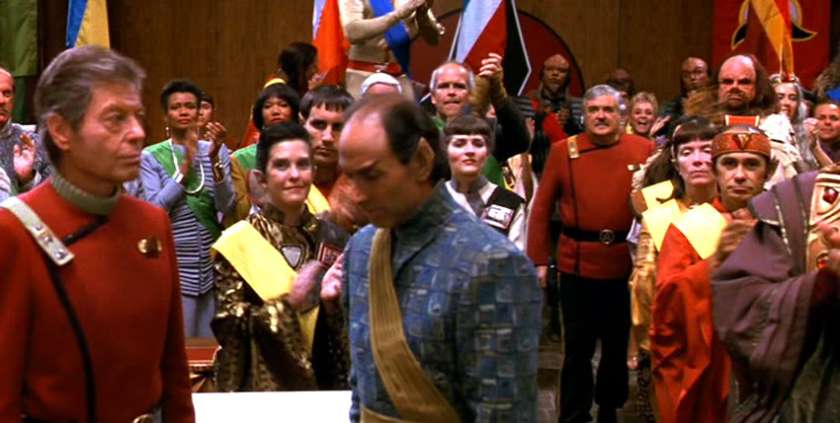
In 2367, a Romulan agent named Selok impersonated Vulcan ambassador T’Pel aboard the USS Enterprise-D. She also wore these gemstones with symbols on them (ST:TNG “Data’s Day”).

It is noteworthy that from 2063-2285 no Vulcan diplomat or politician wore this type of gemstone with symbols. However, from 2286 onward this happens frequently. Could this simply be a change in fashion? Perhaps religious figures began working as diplomats? Or perhaps Vulcan’s government became a theocracy and all or most government officials were also highly religious? There are many possibilities and no concrete answers.
There is one further noteworthy use of these gemstones with symbols on them. In 2370, two members of the crew of space station Deep Space Nine were transported to an alternate universe. In this universe, Vulcans and Humans were slaves to “The Alliance.” A woman referred to as “Intendant” had Vulcan manservants who wore what appeared to be Vulcan priest robes complete with gemstones and symbols (ST: DS9 “Crossover”).

It seems likely that The Alliance forced Vulcans of all walks of life into slavery.
As mentioned above, there are at least 24 distinct symbols used in Vulcan religious clothing. This is more than enough to constitute an alphabet. These could be individual letters, they could be symbols representing words such as rata, tafar and tapan or they could be both. Music is often an important element of religion. These symbols could represent musical notes or sounds used in religious chants. Unfortunately, without more information nothing can be said with certainty.
A third and final part to this series of essays will follow. It will deal with Vulcan symbology and art, architecture and artifacts.
AUTHOR’S NOTE:
This piece is intended as an overview of Vulcan symbols in relation to religion. Any conclusions I have made are based solely on visual evidence provided. The close-up photos of Vulcan clothing and symbols are all taken from It’s A Wrap! Auction listings. Special thanks to everyone at The Star Trek Auction Listings Archive.
Christie’s Connections:
Sarek’s Necklace was sold as #1778, Lot# 562
It’s A Wrap! Connections:
- A Vulcan Khitomer Attendee costume was sold on eBay as IAW Lot# 5309
- A Vulcan Priest costume was sold on eBay as IAW Lot#0620
- A Vulcan Priest costume was sold on eBay as IAW Lot# 1819
- The Vulcan Gong Player’s costume was sold on eBay as IAW Lot# 0976
- A Vulcan Priestess costume was sold on eBay as IAW Lot# 1016
- A Vulcan Maiden costume was sold on eBay as Lot# 6876
- A Vulcan Master’s costume was sold on eBay as Lot# 5860
- Ambassador’s T’Pel’s costume from “Data’s Day” was sold on eBay as IAW Lot #2617
- The Vulcan Master’s costume from “Gravity” was sold on eBay as Lot#4011
- A Vulcan ring was sold on eBay as IAW Lot# 1045
Vulcan gemstones and jewelry were sold on eBay as IAW Lots:
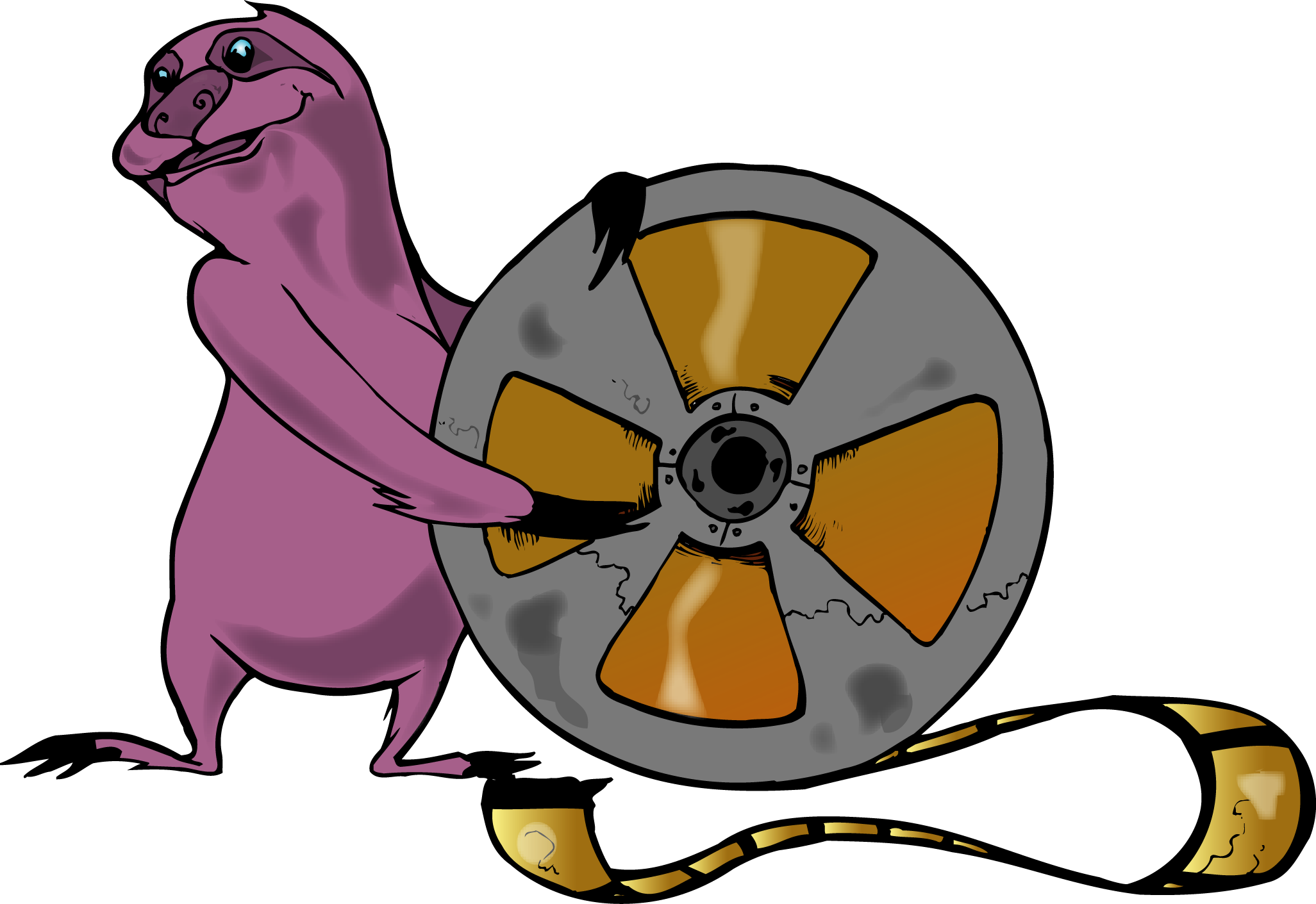



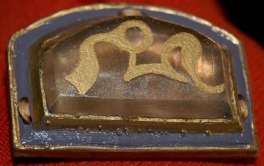







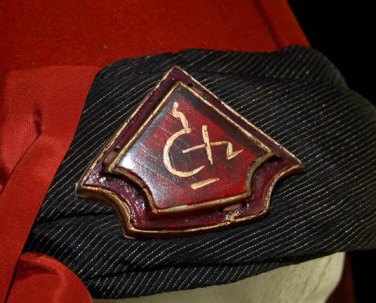






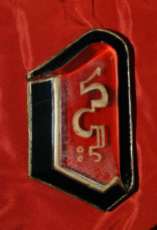




One comment